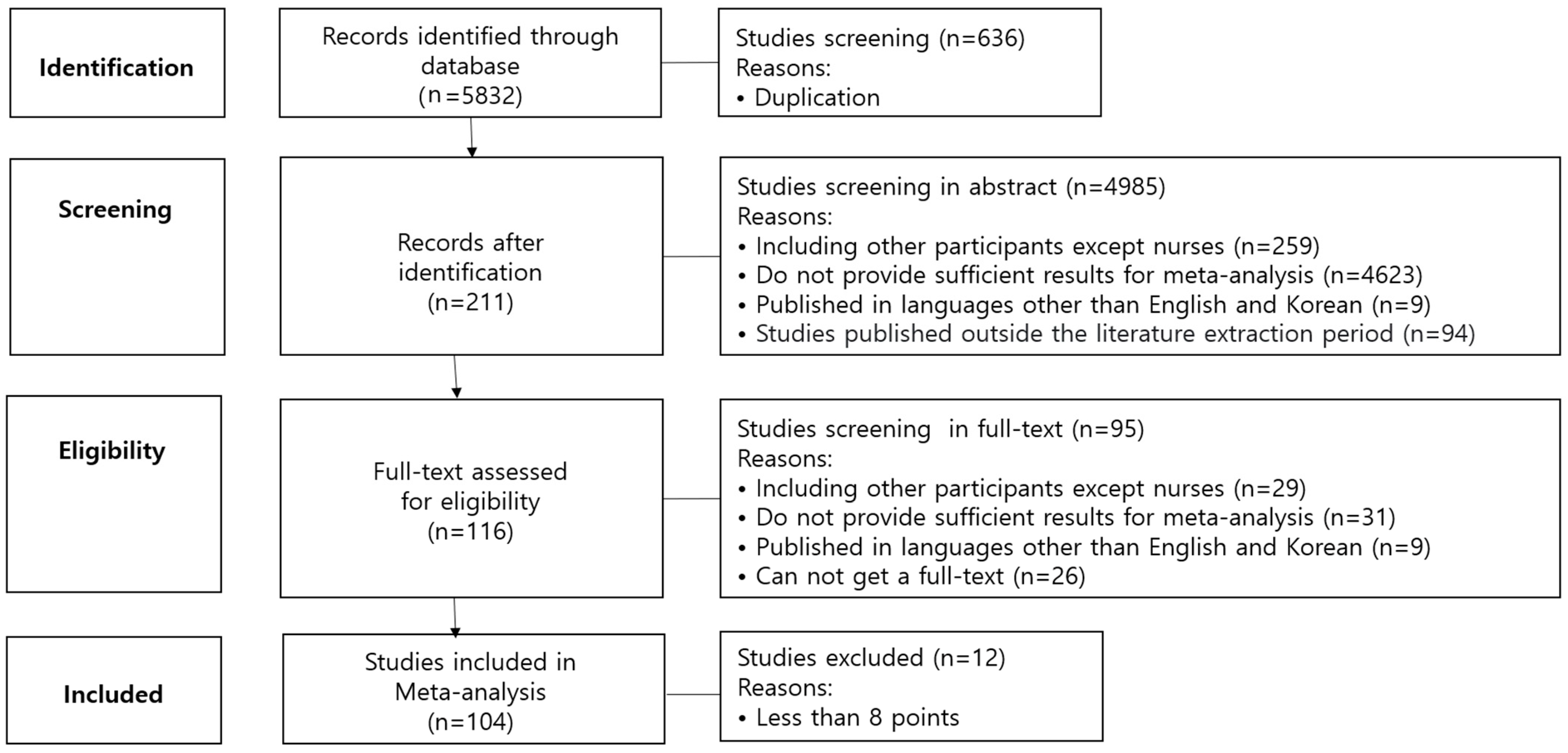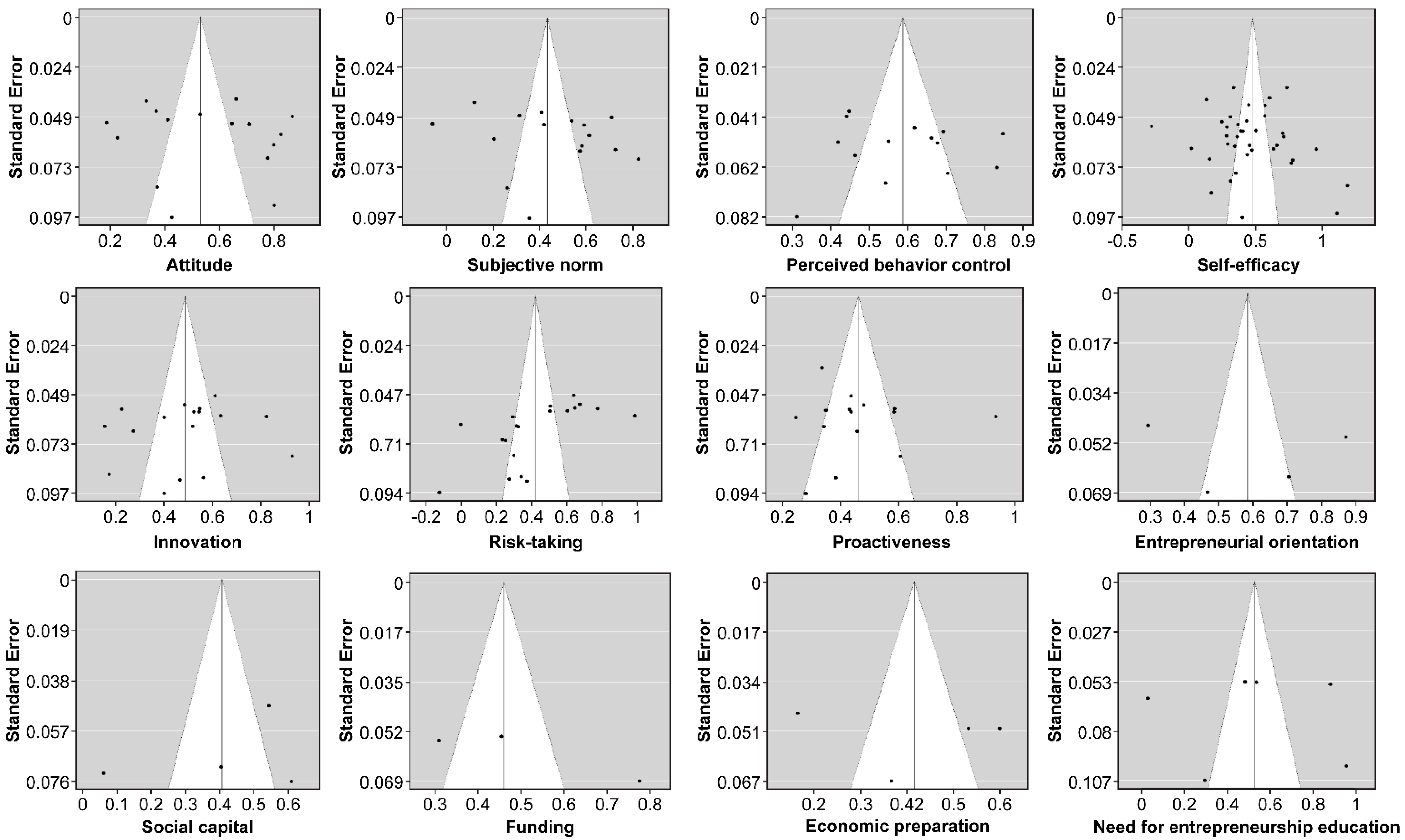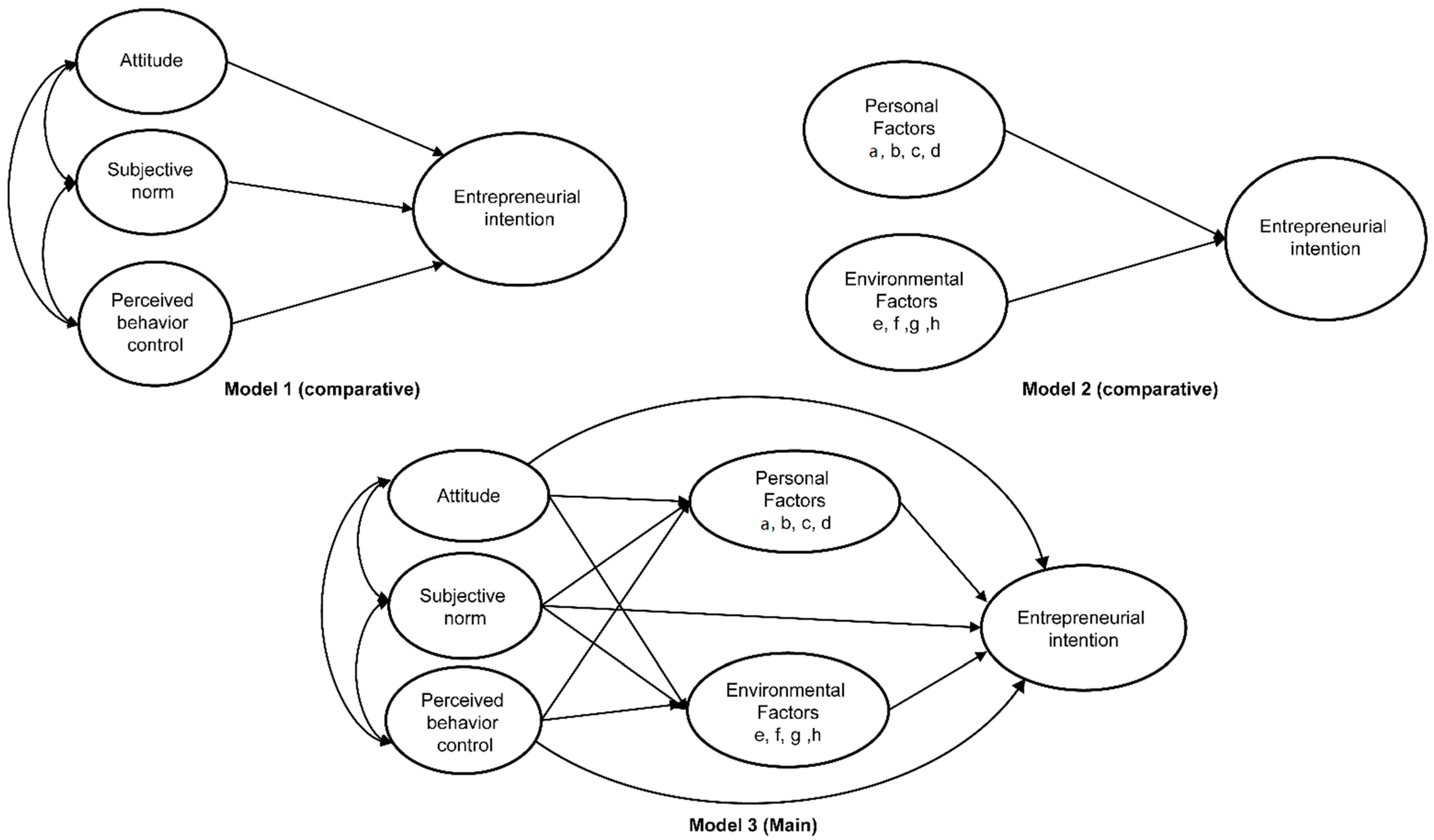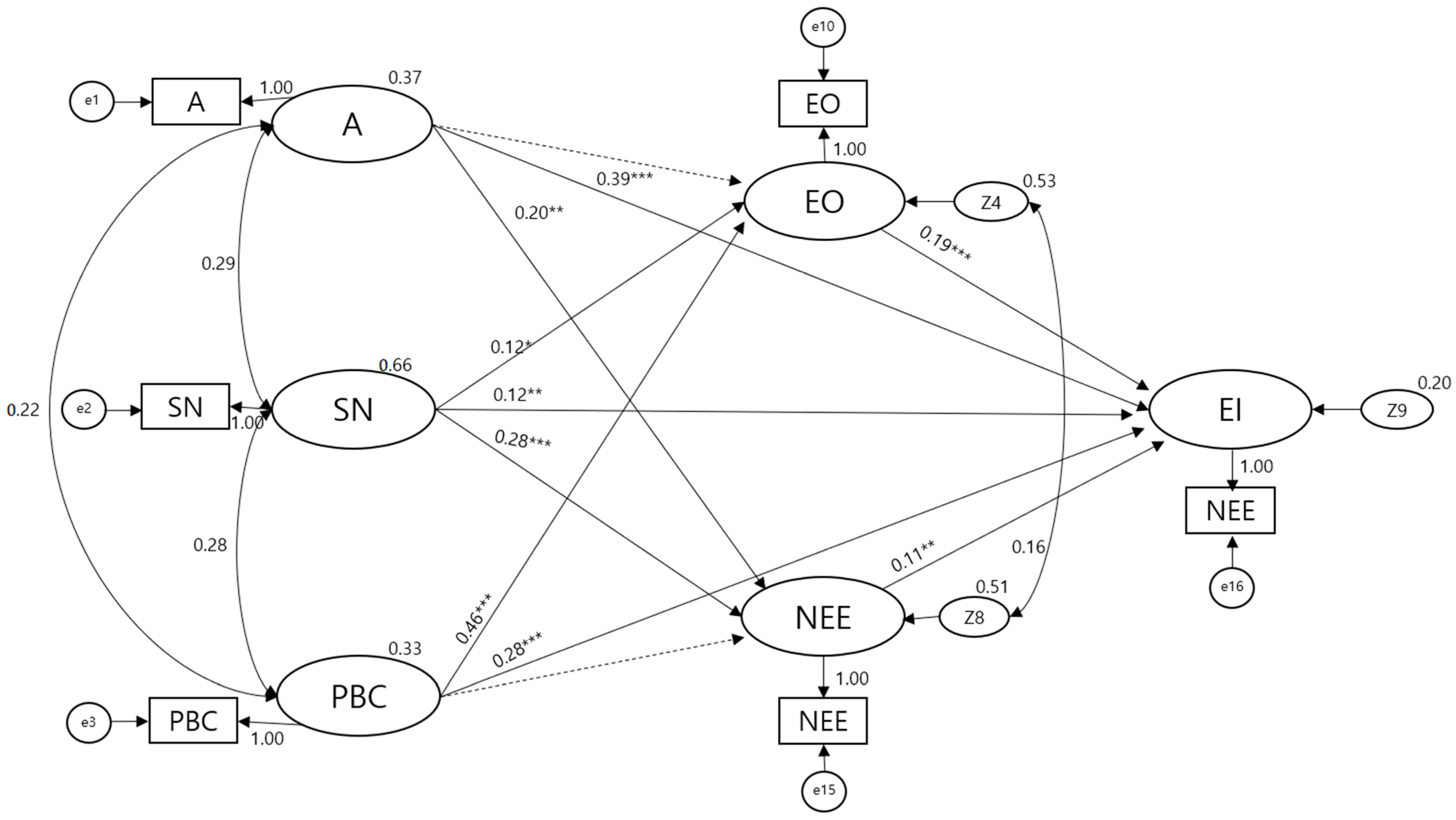Predictive Models for Nurses’ Entrepreneurial Intentions Using Comparison of Competing Models
Abstract
:1. Introduction
2. Materials and Methods
2.1. Construction of the Structural Equation Model
2.2. Model 1
2.3. Model 2
2.4. Model 3
2.5. Sample
2.6. Measures
2.6.1. Entrepreneurial Intention
2.6.2. Planned Behavior
2.6.3. Self-Efficacy
2.6.4. Need for Achievement
2.6.5. Entrepreneurship
2.6.6. Entrepreneurial Orientation
2.6.7. Social Capital
2.6.8. Funding
2.6.9. Economic Preparation
2.6.10. Need for Entrepreneurship Education
2.7. Data Collection and Ethical Considerations
2.8. Data Analysis
3. Results
3.1. Participants’ General Characteristics
3.2. Descriptive Statistics and Confirmatory Factor Analysis of the Measured Variables
3.3. Testing the Fit of Model 3 (Main Model)
3.4. Path Coefficients and Effects in Model 3 (Main Model)
3.5. Comparison with Competing Models
4. Discussion
Limitations
5. Conclusions
Author Contributions
Funding
Institutional Review Board Statement
Informed Consent Statement
Data Availability Statement
Acknowledgments
Conflicts of Interest
References
- Colichi, R.M.B.; Lima, S.G.S.E.; Bonini, A.B.B.; Lima, S.A.M. Entrepreneurship and nursing: Integrative review. Rev. Bras. Enferm. 2019, 72, 321–330. [Google Scholar] [CrossRef]
- Liñán, F.; Fayolle, A. A systematic literature review on entrepreneurial intentions: Citation, thematic analyses, and research agenda. Int. Entrep. Manag. J. 2015, 11, 907–933. [Google Scholar] [CrossRef]
- Krueger, N.F.; Carsrud, A.L. Entrepreneurial intentions: Applying the theory of planned behaviour. Entrep. Reg. Dev. 1993, 5, 315–330. [Google Scholar] [CrossRef]
- Kim, Y.J.; Lim, J.Y. Factors influencing entrepreneurial intention of nursing students based on theory of planned behavior. J. Korean Acad. Nurs. Adm. 2019, 25, 175–185. [Google Scholar] [CrossRef]
- Lee, O.J. A Predictive Model of the Entrepreneurial Intention of Nursing Students. Ph.D. Thesis, Jeonbuk National University, Jeon Ju, Korea, 2016. [Google Scholar]
- Lim, J.Y.; Kim, G.M.; Ko, G.J. Influence of entrepreneurship, personality, traits, and need for entrepreneurial education on entrepreneurial intention in nursing students. J. Korean Data Anal. Soc. 2017, 19, 3361–3377. [Google Scholar] [CrossRef]
- Boyd, N.G.; Vozikis, G.S. The influence of self-efficacy on the development of entrepreneurial intentions and actions. Entrep. Theor. Pract. 1994, 18, 63–77. [Google Scholar] [CrossRef]
- Krueger, N.F., Jr.; Reilly, M.D.; Carsrud, A.L. Competing models of entrepreneurial intentions. J. Bus. Ventur. 2000, 15, 411–432. [Google Scholar] [CrossRef]
- Liñán, F.; Santos, F.J. Does social capital affect entrepreneurial intentions? Int. Adv. Econ. Res. 2007, 13, 443–453. [Google Scholar] [CrossRef]
- Ajzen, I. The theory of planned behavior. Organ. Behav. Hum. Decis. Processes. 1991, 50, 179–211. [Google Scholar] [CrossRef]
- Kang, H. Discussions on the suitable interpretation of model fit indices and the strategies to fit model in structural equation modeling. J. Korean Data Anal. Soc. 2013, 15, 653–668. [Google Scholar]
- Hong, S.H. The criteria for selecting appropriate fit indices in structural equation modeling and their rationales. Korean J. Clin. Psychol. 2000, 19, 161–177. [Google Scholar]
- Autio, E.; Keeley, R.H.; Klofsten, M.; GC Parker, G.; Hay, M. Entrepreneurial intent among students in Scandinavia and in the USA. Enterpr. Innov. Manag. Stud. 2001, 2, 145–160. [Google Scholar] [CrossRef]
- Go, B.H. A Study on the Entrepreneurial Intention and Behavior of the Deluxe Hotel Employees, by Using Extension about Theory of Planned Behavior: Focusing on Career Orientation. Ph.D. Thesis, Kyeonggi University, Seoul, Korea, 2018. [Google Scholar]
- Hwang, S.G. A Study on the Factors That Have Effects on Middle-Aged Employee’s Intention of Business Start-Up; Focusing on Employees over the Age of 40. Master’s Thesis, Chung-Ang University, Seoul, Korea, 2016. [Google Scholar]
- Jie, S.; Harms, R. Cross-cultural competences and international entrepreneurial intention: A study on entrepreneurship education. Educ. Res. Int. 2017, 2017, 9042132. [Google Scholar] [CrossRef]
- Kim, J.H. Start-up Intention Through the Integration of Self-Determination and Goal-Directed Theory. Ph.D. Thesis, Kyung Hee University, Seoul, Korea, 2019. [Google Scholar]
- Van Gelderen, M.; Brand, M.; van Praag, M.; Bodewes, W.; Poutsma, E.; Van Gils, A. Explaining entrepreneurial intentions by means of the theory of planned behavior. Career Dev. Int. 2008, 13, 538–559. [Google Scholar] [CrossRef]
- Cummings, G.; Estabrooks, C.A. The effects of hospital restructuring that included layoffs on individual nurses who remained employed: A systematic review of impact. Int. J. Sociol. Soc. Policy 2003, 23, 8–53. [Google Scholar] [CrossRef]
- Cohen, J. Statistical Power Analysis for the Social Sciences, 2nd ed.; N J Erlbaum: Hillsdale, MI, USA, 1988. [Google Scholar]
- Yook, C.H. Effect of Entrepreneur’s Characteristics on Entrepreneurial Intention; Focusing on the Moderating Effect of Entrepreneurial Mentoring. Ph.D. Thesis, Hoseo University, Asan, Korea, 2015. [Google Scholar]
- Yoon, B.S. Determinants of entrepreneurial intentions: Individual characteristics and environmental factors. Manag. Res. 2004, 17, 89–110. [Google Scholar]
- Hoogland, J.J.; Boomsma, A. Robustness studies in covariance structure modeling: An overview and a meta-analysis. Sociol. Methods Res. 1998, 26, 329–367. [Google Scholar] [CrossRef]
- Crant, J.M. The proactive personality scale as a predictor of entrepreneurial intentions. J. Small Bus. Manag. 1996, 34, 42–49. [Google Scholar]
- Lee, S.G. A Study on the Factors Affecting the Entrepreneurial Intention of Employees. Ph.D. Thesis, Hoseo University, Asan, Korea, 2017. [Google Scholar]
- Liñán, F.; Chen, Y.W. Development and cross-cultural application of a specific instrument to measure entrepreneurial intentions. Entrep. Theor. Pract. 2009, 33, 593–617. [Google Scholar] [CrossRef]
- Sung, C.S. A Study on Factors Influencing Senior Entrepreneurship. Ph.D. Thesis, The Graduate School of Chung-Ang University, Seoul, Korea, 2011. [Google Scholar]
- Gong, J. A Comparative Study on the Factors Influencing the Start-Up Intention of Korean and Chinese University Students. Master’s Thesis, Andong National University, Andong, Korea, 2017. [Google Scholar]
- Bandura, A. Self-efficacy: Toward a unifying theory of behavioral change. Psychol. Rev. 1977, 84, 191–215. [Google Scholar] [CrossRef]
- Lee, S.A. Analysis of Entrepreneurship, Social Capital and Entrepreneurial Intentions of Young Pre-Entrepreneurs: Focusing on Mediating Effects of Entrepreneurial Self-Efficacy and Moderating Effects of Entrepreneurship Education. Ph.D. Thesis, Kyeonggi University, Seoul, Korea, 2019. [Google Scholar]
- Covin, J.G.; Slevin, D.P. A conceptual model of entrepreneurship as firm behavior. Entrep. Theor. Pract. 1991, 16, 7–26. [Google Scholar] [CrossRef]
- Schein, E.H. Career Anchors: Discovering Your Real Values; Pfeiffer and Company: San Diago, CA, USA, 1990. [Google Scholar]
- Kim, E.K. The Effects of Individual Career Orientation and Preparation of the Old Age on the Entrepreneurial Intention: Focusing on the Mediating Effect of the Social Network. Ph.D. Thesis, Hoseo University, Asan, Korea, 2016. [Google Scholar]
- Lee, D.K. The Study on the Influence of Personal and Social Factors on the Entrepreneurial Intention in Young People. Master’s Thesis, Sungkyunkwan University, Seoul, Korea, 2019. [Google Scholar]
- Park, N.T. An Empirical Study on Factors Affecting Entrepreneurial Intention of North Korean Refugees: Focused on the Moderating Effect of Social Adaptability. Ph.D. Thesis, Hoseo University, Asan, Korea, 2017. [Google Scholar]
- Sung, T.J. Easy to Understand Statistical Analysis Using SPSS; Hakjisa: Seoul, Korea, 2016. [Google Scholar]
- Kang, H.C. Understanding and Application of the Structural Equation Model; Korean Society of Nursing Science: Seoul, Korea, 2018. [Google Scholar]
- Bae, B.R. Amos 19 Structural Equation Modeling-Principles and Practices; Cheong Ram: Seoul, Korea, 2011. [Google Scholar]
- Entrialgo, M.; Iglesias, V. The moderating role of entrepreneurship education on the antecedents of entrepreneurial intention. Int. Entrep. Manag. J. 2016, 12, 1209–1232. [Google Scholar] [CrossRef]
- Hsu, D.K.; Burmeister-Lamp, K.; Simmons, S.A.; Foo, M.D.; Hong, M.C.; Pipes, J.D. ‘I know I can, but I don’t fit’: Perceived fit, self-efficacy, and entrepreneurial intention. J. Bus. Ventur. 2019, 34, 311–326. [Google Scholar] [CrossRef]
- Muñoz, C.; Mosey, S.; Binks, M. Developing opportunity-identification capabilities in the classroom: Visual evidence for changing mental frames. Acad. Manag. Learn. Educ. 2011, 10, 277–295. [Google Scholar] [CrossRef]
- Lim, J.Y.; Kim, J.C.; Kim, J.H.; Kim, S.G. Easy to Understand Start up Management for Nurses; H N Media: Paju, Korea, 2019. [Google Scholar]
- Sharp, D.B.; Monsivais, D. Decreasing barriers for nurse practitioner social entrepreneurship. J. Am. Assoc. Nurse Pract. 2014, 26, 562–566. [Google Scholar] [CrossRef]
- Nordin, N.; Wahab, R.A.; Malik, M. Assessing Entrepreneur Education, Perceived Desirability of Self-Employment and Entrepreneur Intention among Trainee Teachers in a Higher Learning Institution. In Proceedings of the ASEAN Entrepreneurship Conference 2014; Springer: Singapore, 2016; pp. 59–69. [Google Scholar]




| Variables | n | Effect Size r | Lower Limit | Upper Limit | I2 (%) | Q | p | Tau2 | |
|---|---|---|---|---|---|---|---|---|---|
| Theory of planned behavior | Attitude | 17 | 0.492 | 0.404 | 0.571 | 3.00 | 16.49 | <0.001 | 0.85 |
| Subjective norm | 17 | 0.408 | 0.306 | 0.500 | 0.00 | 15.34 | <0.001 | 0.96 | |
| Perceived behavior control | 14 | 0.529 | 0.469 | 0.584 | 6.49 | 13.90 | <0.001 | 0.26 | |
| Personal factors | Self-efficacy | 39 | 0.442 | 0.373 | 0.506 | 21.11 | 48.17 | <0.001 | 2.56 |
| Need for achievement | 13 | 0.353 | 0.282 | 0.420 | 0.00 | 11.33 | <0.001 | 0.22 | |
| Innovation | 17 | 0.452 | 0.374 | 0.525 | 8.53 | 17.49 | <0.001 | 0.61 | |
| Risk-taking | 21 | 0.402 | 0.309 | 0.488 | 3.75 | 20.78 | <0.001 | 1.21 | |
| Proactiveness | 15 | 0.435 | 0.365 | 0.500 | 3.33 | 14.48 | <0.001 | 0.36 | |
| Entrepreneurial orientation | 4 | 0.526 | 0.293 | 0.700 | 0.00 | 2.38 | <0.001 | 0.32 | |
| Environmental factors | Social capital | 4 | 0.385 | 0.180 | 0.558 | 10.83 | 3.37 | <0.001 | 0.19 |
| Funding | 4 | 0.429 | 0.260 | 0.572 | 18.31 | 3.67 | <0.001 | 0.14 | |
| Economic preparation | 4 | 0.393 | 0.203 | 0.555 | 0.00 | 2.49 | <0.001 | 0.17 | |
| Need for entrepreneurship education | 6 | 0.487 | 0.258 | 0.665 | 8.84 | 5.49 | <0.001 | 0.64 | |
| Variables | Categories | n | % | M ± SD |
|---|---|---|---|---|
| Gender | female | 363 | 94.0 | |
| male | 23 | 6.0 | ||
| Age | ≤29 | 136 | 35.2 | 33.98 ± 7.13 |
| 30~39 | 151 | 39.2 | ||
| 40~49 | 90 | 23.3 | ||
| ≥50 | 9 | 2.3 | ||
| Education | College | 152 | 39.4 | |
| University | 216 | 56.0 | ||
| Graduate | 18 | 4.6 | ||
| Marital status | Married | 173 | 44.8 | |
| Unmarried | 209 | 54.2 | ||
| Others | 4 | 1.0 | ||
| Department | Ward | 220 | 57.0 | |
| Operation room | 105 | 27.2 | ||
| Out-patient department | 51 | 13.2 | ||
| Others | 10 | 2.6 | ||
| Position | Staff nurse | 256 | 66.3 | |
| Charge nurse | 84 | 21.8 | ||
| Head nurse | 46 | 11.9 | ||
| Family start-up experience | Yes | 152 | 39.4 | |
| No | 234 | 60.6 | ||
| Whether to take EE | Yes | 9 | 2.3 | |
| No | 377 | 97.7 | ||
| Desired nursing start-up field * | Elderly care facility | 144 | 37.3 | |
| Alternative nursing | 59 | 15.3 | ||
| Medical institution consulting | 45 | 11.7 | ||
| Postpartum care and breastfeeding | 40 | 10.4 | ||
| Nursing-related academy | 32 | 8.3 | ||
| Kindergarten | 26 | 6.7 | ||
| Lunch box for chronic disease | 24 | 6.2 | ||
| Rental shop for elderly equipment | 16 | 4.2 | ||
| Hospice center | 16 | 4.2 | ||
| Others | 37 | 9.6 | ||
| Hindering factors for nursing start-up * | Lack of funds | 180 | 46.6 | |
| Lack of knowledge | 151 | 39.1 | ||
| Fear of failure | 65 | 16.8 | ||
| Lack of confidence | 63 | 16.3 | ||
| Worries around | 22 | 5.7 | ||
| Others | 13 | 3.4 | ||
| Success factors for nursing start-up * | Start-up knowledge | 159 | 41.2 | |
| Start-up fund | 125 | 32.4 | ||
| Start-up role model | 98 | 25.4 | ||
| Start-up experience | 49 | 12.7 | ||
| Start-up confidence | 25 | 6.5 | ||
| Others | 6 | 1.6 |
| Variable | Range | M ± SD | Skewness | Kurtosis | Standardized Factor Loading | AVE | CR |
|---|---|---|---|---|---|---|---|
| Attitude | 1–5 | 2.78 ± 0.74 | −1.97 | 1.47 | |||
| SN | 1–5 | 2.92 ± 0.81 | −3.09 | 0.08 | |||
| PBC | 1–5 | 2.60 ± 0.67 | −2.80 | 1.09 | |||
| Self-efficacy | 1–5 | 3.38 ± 0.56 | −0.90 | −0.09 | |||
| Need for achievement | 3.41 ± 0.54 | −0.77 | 1.07 | 0.871 | 0.930 | ||
| Relative NA | 1–5 | 3.36 ± 0.58 | −0.65 | 0.87 | 0.76 | ||
| Active NA | 1–5 | 3.53 ± 0.61 | −0.06 | 0.40 | 0.92 | ||
| Entrepreneurship | 3.06 ± 0.51 | 2.93 | 3.16 | 0.692 | 0.865 | ||
| Innovation | 1–5 | 3.00 ± 0.58 | 2.32 | 1.04 | 0.77 | ||
| Risk-taking | 1–5 | 3.35 ± 0.61 | −0.05 | 1.34 | 0.81 | ||
| Proactiveness | 1–5 | 3.22 ± 0.72 | 2.58 | 0.58 | 0.47 | ||
| EO | 1–5 | 2.76 ± 0.81 | 2.07 | 0.65 | |||
| Social capital | 2.65 ± 0.58 | 3.25 | 0.42 | 0.824 | 0.904 | ||
| GEN | 1–5 | 2.83 ± 0.92 | 1.52 | 0.00 | 0.88 | ||
| NEN | 1–5 | 2.37 ± 0.83 | 3.02 | 0.39 | 0.86 | ||
| Funding | 1–5 | 3.00 ± 0.78 | −1.71 | 1.26 | |||
| EP | 1–5 | 3.24 ± 0.72 | −0.52 | 0.13 | |||
| Need for EE | 1–5 | 3.14 ± 0.79 | −1.41 | 3.27 | |||
| EI | 1–5 | 2.49 ± 0.71 | 0.25 | −0.88 |
| Model | Endogenous Variables | Exogenous Variables | S.E | C.R (p) | Direct Effect (p) | Indirect Effect (p) | Total Effect (p) | SMC |
|---|---|---|---|---|---|---|---|---|
| M1 | EI | Attitude | 0.05 | 7.85 (<0.001) | 0.427 (<0.001) | 0.427 (<0.001) | 0.543 | |
| SN | 0.07 | 6.29 (<0.001) | 0.269 (<0.001) | 0.269 (<0.001) | ||||
| PBC | 0.05 | 4.03 (<0.001) | 0.309 (<0.001) | 0.309 (<0.001) | ||||
| M2 | EI | EO | 0.05 | 5.36 (<0.001) | 0.252 (<0.001) | 0.252 (<0.001) | 0.358 | |
| Social capital | 0.07 | 3.98 (<0.001) | 0.274 (<0.001) | 0.274 (<0.001) | ||||
| Need for EE | 0.04 | 5.11 (<0.001) | 0.214 (<0.001) | 0.214 (<0.001) | ||||
| M3 | EI | Attitude | 0.05 | 7.58 (<0.001) | 0.334 (<0.001) | 0.021 (0.010) | 0.355 (<0.001) | 0.600 |
| SN | 0.04 | 3.13 (0.002) | 0.137 (0.002) | 0.052 (0.001) | 0.189 (0.002) | |||
| PBC | 0.06 | 4.99 (<0.001) | 0.229 (<0.001) | 0.086 (<0.001) | 0.315 (<0.001) | |||
| EO | 0.03 | 5.73 (<0.001) | 0.214 (<0.001) | 0.214 (<0.001) | ||||
| Need for EE | 0.03 | 3.23 (0.001) | 0.120 (0.001) | 0.120 (0.001) |
Publisher’s Note: MDPI stays neutral with regard to jurisdictional claims in published maps and institutional affiliations. |
© 2022 by the authors. Licensee MDPI, Basel, Switzerland. This article is an open access article distributed under the terms and conditions of the Creative Commons Attribution (CC BY) license (https://creativecommons.org/licenses/by/4.0/).
Share and Cite
Kim, Y.-J.; Lim, J.-Y. Predictive Models for Nurses’ Entrepreneurial Intentions Using Comparison of Competing Models. Int. J. Environ. Res. Public Health 2022, 19, 6027. https://doi.org/10.3390/ijerph19106027
Kim Y-J, Lim J-Y. Predictive Models for Nurses’ Entrepreneurial Intentions Using Comparison of Competing Models. International Journal of Environmental Research and Public Health. 2022; 19(10):6027. https://doi.org/10.3390/ijerph19106027
Chicago/Turabian StyleKim, Ye-Jung, and Ji-Young Lim. 2022. "Predictive Models for Nurses’ Entrepreneurial Intentions Using Comparison of Competing Models" International Journal of Environmental Research and Public Health 19, no. 10: 6027. https://doi.org/10.3390/ijerph19106027
APA StyleKim, Y.-J., & Lim, J.-Y. (2022). Predictive Models for Nurses’ Entrepreneurial Intentions Using Comparison of Competing Models. International Journal of Environmental Research and Public Health, 19(10), 6027. https://doi.org/10.3390/ijerph19106027







